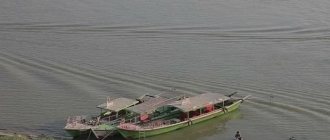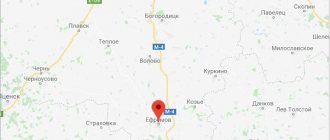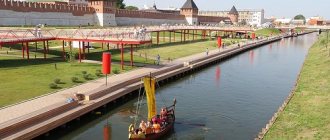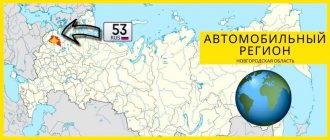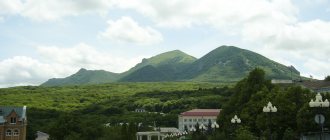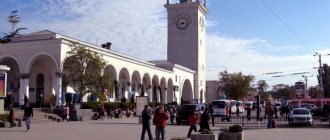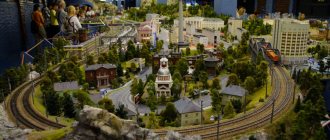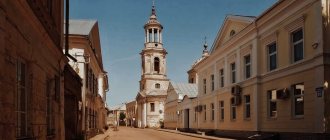VOLOKOLAMSK
VOLOKOLAMSK, a city in Russia, in the northwestern part of the Moscow region, the center of the Volokolamsk urban district. Population 18.4 thousand people. (2019). Located on the slopes of the Smolensk-Moscow Upland, on the river. Gorodenka, near its confluence with the river. Lama, 4 km from the railway station of the same name. Road junction.
Story
Photo by A.I. Nagaev Volokolamsk. Kremlin ensemble. 2nd half 15th – 19th centuries
The city was first mentioned in the Laurentian Chronicle in 1135 as Volok, later – Volok on Lama, Volok (Lamsky). It was located on an important trade route connecting the Novgorod lands with the Volga-Oka basin (near Volokolamsk, ships were dragged from the Lama River to the upper reaches of Voloshna or Ozerna). In the 12th–14th centuries. object of confrontation between the Novgorod Republic and the Grand Duchy of Vladimir, later the Principality of Moscow. In 1178 he was burned by the Prince of Vladimir. Vsevolod Yuryevich Big Nest. At the end of the 12th - mid-15th centuries. was under the joint control of the Novgorod Republic and the princes (later the Grand Dukes) of Vladimir. In 1238 it was devastated during the Mongol-Tatar invasion, and in 1293 it was attacked by the Tatar army of Duden. In 1285 Volochans took part in a campaign against Lithuanian lands. From 1328–29, the grand-ducal part of the city was under the jurisdiction of the Moscow princes. In 1370 the city withstood a siege by the troops of the Lithuanian prince Olgerd. By the beginning of the 1380s. acquired the significance of a strategically important fortress. In 1390 it was given into the possession of Prince Vladimir Andreevich, but according to an agreement he concluded between 1404 and 1406 with the Grand Duke of Moscow Vasily I Dmitrievich, it again became a grand-ducal possession and until 1462 it was governed by Ch. arr. serving princes. In 1462–1513, as part of the Grand Duchy of Moscow, there was an appanage Principality of Volotsk, allocated by the Grand Duke of Moscow Vasily II Vasilyevich to his son Boris Vasilyevich. After the death of Prince Fyodor Borisovich in 1513, his principality became part of the grand ducal possessions. From the end of the 1520s. The military-strategic importance of the city decreased. In October - November 1606 it was occupied by one of the detachments of I. I. Bolotnikov's troops, in August 1608 - by Polish troops during the intervention of the Polish-Lithuanian Commonwealth in the early 17th century. Liberated in 1609, in 1612 he successfully withstood the siege of Polish troops. After the Time of Troubles, the city's territory shrank. In 1708–1929 – a district town in the Moscow province. One of the centers of the partisan movement in the Patriotic War of 1812.
In 1904, a section of the Moscow-Vindavskaya railway was laid through Volokolamsk. d. During the Revolution of 1905–07 in the vicinity of Volokolamsk, the so-called. Markov Republic (October 1905 – June 1906). On December 22, 1917, Soviet power was established. In 1929–2019 - the regional center of the Moscow region. During the Battle of Moscow 1941–42, stubborn battles between the Red Army and German troops took place in the Volokolamsk region; in October–December 1941 the city was occupied. Liberated on December 20, 1941 during the Klin-Solnechnogorsk operation. City of regional subordination (1963–2001, since 2019) of the Moscow region. City of Military Glory (2010). From 2022 the center of the urban district.
Architecture. Cultural centers
The center of Volokolamsk with an earthen rampart and a wooden fortress (kremlin) was located on the top of a hill, where in the 2nd half of the 15th century. a stone, single-domed, 4-pillar Resurrection Cathedral was erected (a fragment of the original painting has been preserved); the settlement stretched along the river. Gorodenka. Preserved: the Church of Peter and Paul (1694, significantly rebuilt in 1830, 1886) - the former cathedral of Vlasievsky Monastery. (abolished in 1764), Church of the Intercession (1695, rebuilt in 1806, 1870) - the former Assumption Cathedral of the Varvara Monastery (abolished in 1764) - with a bell tower (1876–78). During the redevelopment of Volokolamsk at the end of the 18th century. The city structure has largely been preserved, the administrative complex with government offices (1813–15, architect S. E. Tatarinov) was located near the Resurrection Cathedral. In 1853–64, St. Nicholas Cathedral was erected in the Kremlin in the neo-Russian style. Residential buildings until the fire of 1905 remained predominantly wooden. Since the 1950s the southwestern and southern outskirts of Volokolamsk were built up. The Volokolamsk Kremlin Museum and Exhibition Complex (founded in 1987, opened in 1989), Volokolamsk Historical and Architectural Museum (1962; modern name since 1989). Since 1991, the youth music festival “Voices of the Lama” has been held annually.
Farm
The following enterprises operate: Volokolamsk Auto-Aggregation Plant (pneumatic compressors for brake systems of trucks), Can-Pack Packaging Plant (aluminum beverage cans), woodworking enterprises, Volokolamsk Textile Factory and food industry enterprises.
Neighborhood
On the outskirts of Volokolamsk, in the village. Vozmishche - the three-domed, 4-pillar Church of the Nativity of the Virgin Mary (1537, rebuilt in 1792, 1850; originally the cathedral of the Vozmice Monastery, abolished in 1764; frescoes from the 16th century have been partially preserved) with a bell tower (1850, architect D. M. Petropavlovsky). Near V. - the estates of the Goncharovs and Chernyshevs in the village. Yaropolets. In the village In Kashino, in 1920, one of the country's first rural locomotive power plants was opened (now a museum). Not far from Volokolamsk there is the Dubosekovo junction, in the village of Nelidovo there is a Museum and the Mass Grave of Panfilov heroes. 15 km from Volokolamsk is the estate of the princes Urusov, Muravyov and Grand Duke Konstantin Konstantinovich in the village. Ostashovo [two residential wings, an office and the manager’s house, entrance towers, late 18th century, have been preserved; horse yard (1840s); church-burial vault (1915, architects M. M. Peretyatkovich, S. M. Deshevov)]. 25 km from Volokolamsk, in the village. Teryaevo, - ensemble of the Joseph-Volotsky Monastery.
City `s history
Volokolamsk
Volokolamsk is a city of district subordination in the Moscow region of Russia, the administrative center of the Volokolamsk district and the urban settlement of Volokolamsk.
In 2010, by decree of the President of the Russian Federation, the city was awarded the title - City of Military Glory. Population - 20,838 people. (2017). Located on the Baltic federal highway, 98 km west of Moscow (from the Moscow Ring Road). The historical center is located on the Gorodnya River (a tributary of the Lama), 5 km north of the Volokolamsk railway station on the Moscow-Riga line.
Since 2003, after the working village of Privokzalny and the village of Porokhovo became part of Volokolamsk, the railway station and the Lama River are also located on the territory of the city.
- Geography
- Story
- Population
- Economy
- Transport
- Education
- Culture
- Religion
- Main city streets
- Attractions
- Famous people
- Twin Cities
Geography
Volokolamsk is located 100 km from the Moscow Ring Road northwest of Moscow. The area of urban land is 30–35 km². As a result of the expansion of the borders, the territory of the city increased significantly - the city stretched in the meridional direction for 14 km.
Story
Mentioned for the first time in the Suzdal Chronicle according to the Laurentian list in 1135: “Vsevolod went again to Novugorod, and Izyaslav remained on Volots”; with a localizer adjective it was mentioned in the same source, but under the year 1178: “going to Lamsky Volok.” Thus, Volokolamsk is the oldest city in the Moscow region: its age exceeds the age of Moscow by 12 years. It was called Volok Lamsky or simply Volok until the 18th century.
The name comes from the ancient Russian geographical term portage, which was already used in the Tale of Bygone Years in describing the route from the Varangians to the Greeks.
Volok Lamsky became an important trading point on the way from Novgorod to the Ryazan and Moscow lands; here the Novgorodians transported (“dragged”) ships from the Lama River, a tributary of the Shosha, which flows into the Volga in its upper reaches - to Voloshnya, a tributary of the Ruza River, which flows into the Moscow River, which in turn is a tributary of the Oka.
Having great military-strategic significance, Volok on Lama already in the second half of the 12th century became the subject of disputes between Novgorodians and Vladimir residents: in 1160 it was captured by the son of Yuri Dolgoruky, Andrei Bogolyubsky; in 1177 it was recaptured by the Novgorodians and given to Prince Yaroslav Mstislavich, the grandson of Yuri Dolgoruky; in 1216, the Vladimir prince Yaroslav Vsevolodovich began to rule it; soon expelled from here by the Novgorodians, he returned again 10 years later. In the XII-XIII centuries, Volokolamsk was ruined more than once: in 1178 - by Prince Vsevolod Yuryevich, by whom the city was completely burned; in 1238 - Batu; in 1273 - Prince of Tver Svyatoslav Yaroslavich, in 1293 - Khan Duden).
From the end of the 13th century, Volok Lamsky was under “local” control of the Novgorod Republic and Moscow; however, at the beginning of the 14th century, the Moscow governor Rodion Nestorovich, appointed to it by Ivan Kalita, expelled the Novgorodian, completely taking possession of the city. Since 1345, Fyodor Dorogobuzhsky, father-in-law of the Moscow prince Simeon the Proud, began to reign in Volokolamsk. In 1371, Volok, which was then headed by the Smolensk prince Vasily Ivanovich Berezuisky, withstood a three-day siege of the Lithuanian prince Olgerd, and in 1382 repelled an attack by Tokhtamysh’s troops. In 1393, by order of Vasily I, it was captured by the Serpukhov prince Vladimir Andreevich.
In 1398, Volok Lamsky was given to the Lithuanian prince Svidrigailo and was under his command until 1410. In 1462, the city became the center of an appanage principality (known as the Volotsk principality), which (in addition to Volokolamsk) included the cities of Ruza (in 1504 it passed to Moscow) and Rzhev; for a long time (from 1462 to 1494) it was ruled by Boris Vasilyevich), who was replaced by his son Fyodor Borisovich; under him, the Volokolamsk lands finally entered Moscow’s sphere of influence. After the death of Fyodor Borisovich, in 1513, Volokolamsk became part of the Moscow Principality; The Volokolamsk appanage principality was abolished. For some time it was part of the Staritsa principality; at the beginning of the 16th century the city was the volost center of the Moscow principality.
During the Time of Troubles it was occupied by the Poles (1606), and liberated in 1608. Besieged unsuccessfully by Sigismund (1612); A peasant war was fought in the vicinity of Volokolamsk.
In the XVI-XVII centuries. the strategic importance of the city fell; in the 18th century he found himself on the sidelines of new economic ties. However, in 1781 Volokolamsk retained its status as a district town; in 1784 the master plan for its development was approved; in 1790, the first educational institution was opened in the city - a junior public school. On seven streets and several alleys there were 240 houses, 35 trading shops, 6 inns, a tavern, 2 blacksmiths, 5 drinking houses; the number of inhabitants did not exceed 1300 people.
“Plan of the district town of Volokolamsk and its pasture lands.” Collection of materials for the study of Moscow and the Moscow province. Issue I. - Moscow, 1864
In the “List of Populated Places” of 1862, Volokolamsk is a district town of the Moscow province on the Volokolamsk tract, near the Lama and Gorodnya rivers, 783 versts from St. Petersburg, with 220 houses and 2412 residents (1143 men, 1269 women). The city had six Orthodox churches, parish and district schools, a hospital, a postal station, a factory, two factories and two fairs.
At the end of the 19th century, Volokolamsk had several industrial enterprises; the largest enterprise was the weaving factory of the Starshinov brothers, founded in 1882 in the village of Shchekino, 3 kilometers from the city; in the city itself there were two malt houses, a brewery and two brick factories. Fair trade was carried out. By the beginning of the 20th century, workers made up less than 2 percent of the total population.
Plan of Volokolamsk in 1909. "Companion on the Moscow-Vindava Railway." M.: Printing house of S. P. Yakovlev, 1909
In 1904, the Moscow-Vindava Railway approached Volokolamsk; this event, however, did little to contribute to the development of the economy of Volokolamsk, formerly a major trading center. Volokolamsk workers showed high activity in the strike movement of 1905 (in November, the largest enterprise in the city, the weaving factory of the Starshinov brothers, stopped). On October 31, the peasants of the surrounding villages entered the self-proclaimed Markov Republic (named after the village of Markovo, Volokolamsk district, the place where the republic was proclaimed). The Peasant Republic was liquidated only in July 1906.
After the February Revolution of 1917, the most significant positions in the zemstvo government of Volokolamsk were occupied by the Socialist Revolutionaries and Mensheviks. This situation remained until December 22, 1917, when the zemstvo recognized Soviet power. During 1918, almost all Volokolamsk enterprises (including the Starshinov brothers' factory) were nationalized. In 1919, the first issue of the district newspaper “The Voice of the Poor” (later “The Red Plowman”) was published. In 1922, the former Starshinov factory was named after V.I. Lenin. In 1929, the city became the center of the Volokolamsk region.
From October 27 to December 20, 1941, the city of Volokolamsk was occupied by German troops. The city was liberated from the Nazi occupation by troops of the 20th Army under the command of Major General Andrei Andreevich Vlasov. Awarded the Order of the Patriotic War, 1st degree (1985).
On March 25, 2010, Volokolamsk was awarded the honorary title of the Russian Federation “City of Military Glory.” On October 17, 2013, as part of a series of commemorative coins of the Central Bank of the Russian Federation dedicated to cities of military glory, a 10-ruble “Volokolamsk” coin was issued. On December 20, 2014, on the territory of the Volokolamsk garment factory, between Sergacheva and Novo-Soldatskaya streets, the grand opening of the “City of Military Glory” stela took place.
Expansion of city boundaries
Vozmishchensky Church (XVI century)
By decision of the Moscow Regional Executive Committee of April 15, 1959 No. 377, the settlements of Novaya and Staraya Soldatskie Sloboda of the Suburban Village Council were included within the city limits.
In 1963, the urban-type settlement of Smychka was included in Volokolamsk.
In the early 2000s. The territory of Volokolamsk was significantly expanded at the expense of neighboring settlements. In 2003, the village of Volokolamets and the urban-type settlement of Privokzalny, to which the village of Porokhovo had previously been annexed, were annexed to the city; in 2004 - the village of Kholmogorka, the villages of Matveykovo, Kholstnikovo, Shchekino and the village of Vozmishche, as well as the village of Novopetrovskoye.
Population
Population
| 1852 | 1856 | 1859 | 1897 | 1913 | 1923 | 1926 | 1931 |
| 1290 | 2100 | 2412 | 3091 | 3500 | 3796 | 3131 | 4900 |
| 1939 | 1959 | 1967 | 1970 | 1979 | 1989 | 1992 | 1998 |
| 5413 | 8625 | 15000 | 15495 | 18356 | 18226 | 18300 | 17900 |
| 2000 | 2001 | 2002 | 2003 | 2005 | 2006 | 2008 | 2009 |
| 17700 | 17600 | 16656 | 16700 | 24800 | 24500 | 24000 | 23856 |
| 2010 | 2011 | 2012 | 2013 | 2014 | 2015 | 2016 | 2017 |
| 23433 | 23400 | 22857 | 22439 | 21692 | 21212 | 20976 | 20838 |
| 2018 | 2019 | 2020 | 2021 | ||||
| 19824 | 19162 | 18372 |
As of January 1, 2022, in terms of population, the city was in 687th place out of 1,115 cities in the Russian Federation.
Economy
Volokolamsk has a well-developed industry. Below are some of the city's businesses.
- Lear LLC - production of components for Ford cars.
- "3M Russia" - production of anti-corrosion materials.
- Can-Pack Packaging Plant LLC - production of aluminum beverage cans.
- Europlast LLC - production of products and accessories for the bathroom and toilet.
- — production of products from wood-polymer composite.
- Volokolamsk Dairy Plant.
- Confectionery factory "Aladdin".
- Deka LLC is a pate production plant.
Transport
- 5 (Factory - Volokolamsk station)
- 22 (Volokolamsk (Bus station) - Karacharovo)
- 23 (Volokolamsk (Bus station) - Ilyino - Teryaevo)
- 24 (Volokolamsk (Bus station) - Sychevo)
- 26 (Volokolamsk (Bus station) - Kamenki)
- 27 (Volokolamsk (Bus station) - Red Mountain - M. Sytkovo)
- 28 (Lotoshino - Volokolamsk station)
- 29 (Volokolamsk (Bus station) - Gorbunovo)
- 31 (Volokolamsk (Station) - Shanino)
- 32 (Shakhovskaya - Volokolamsk)
- 37 (Lotoshino - Maksimovo)
- 38 (Lotoshino - Palkino)
- 39 (Lotoshino - Mikulino)
- 40 (Lotoshino - agricultural Vvedensky)
- 41 (Istra (New Jerusalem) - Sychevo)
- 42 (Volokolamsk - Dubosekovo)
- 47 (Lotoshino - Zvanovo)
- 48 (Volokolamsk (Bus station) - Kalistovo)
- 50 (st. Volokolamsk - Osheikino)
- 52 (Lotoshino - Torfyanoy)
- 53 (Lotoshino - Markovo)
- 54 (st. Volokolamsk - Lvovo)
- 54 (Lotoshino - Osheikino)
- 55 (Klin - Shanino)
- 56 (Lotoshino - Novo-Vasilievskoye)
- 57 (Lotoshino - Pochinki)
- 58 (Lotoshino - Konoplevo)
- 61 (Lotoshino - Mikhalevo)
- 64 (Lotoshino - Zvyagino)
- 65 (Lotoshino - Oreshkovo)
- 68 (Lotoshino - Streshnevy Gory)
- 69 (Volokolamsk (Bus station) - Golubtsovo)
- 70 (Lotoshino - Volodino)
- 71 (Volokolamsk (Bus station) - Vladychino)
- 307 (Volokolamsk (Bus station) - Moscow (metro station "Tushinskaya"))
- 467 (Lotoshino (Bus station) - Moscow (metro station "Tushinskaya"))
- 961 (Moscow (metro station "Tushinskaya") - Rzhev)
- 963 (Staritsa - Moscow (metro station "Tushinskaya"))
- 964 (Ostashkov - Moscow (metro station "Tushinskaya"))
Education
The following educational institutions are located in the city:
- Volokolamsk branch of Moscow State University of Technology and Management
- Russian New University, Volokolamsk branch
- Volokolamsk Institute of Hospitality - branch of the Russian International Academy of Tourism
- Volokolamsk Agrarian College "Kholmogorka"
- Volokolamsk branch of the state budgetary educational institution of secondary vocational education of the Moscow region "Krasnogorsk College" (formerly the College of Law, Economics and Security; vocational school No. 53)
- Gymnasium No. 1; three secondary schools - No. 2, No. 3 (formerly Leninskaya) and Privokzalnaya; two main secondary schools - Porokhovskaya and boarding school; three primary comprehensive schools - No. 4, No. 5 and No. 6.
Culture
Since the beginning of the 20th century, the Volokolamsk People's Theater has existed in the city, which in 1959 was awarded the title “People's Collective”.
Since 2004, the international festival of military-patriotic film “Volokolamsk Frontier” named after Sergei Bondarchuk has been held annually.
In the city there are: the Central City Library, several small libraries, the House of Children's Creativity, the Volokolamsk Regional Center of Culture and Creativity "Springs" and three houses of culture - "Volokolamets", "Cosmos" and "Textilshchik".
Since 1962, the Volokolamsk children's music school has been operating. Founder: Vladimir Izrailevich Shukhat.
Religion
Russian Orthodox Church
- Resurrection Cathedral (City Val)
- Church of the Intercession (Dovatora street, building 9).
- Church of the Nativity of the Virgin Mary (Vozmishche St., 14).
- Church of the Nativity of Christ (Revolyutsionnaya St., building 7).
- Peter and Paul Church (Sovetskaya str., building 28).
Church of Evangelical Christian Baptists
- House of prayer of Evangelical Christian Baptists (Dobrovolsky St., building 1).
Islam
- House of worship on the Northern Highway.
Main city streets
- Vozmishche (formerly Vozmitskaya Sloboda, until 2006 - a village). House 14 - Church of the Nativity of the Blessed Virgin Mary (until 1764 - a monastery). House 20 is multifunctional.
- Gorval (the oldest; short for “City Wall”). The former name was Fortress Val. Museum and exhibition complex "Volokolamsk Kremlin". SIZO-2. Hotel "Nicol".
- Dovatora. House 9 - Church of the Intercession of the Blessed Virgin Mary. Pokrovskoe cemetery.
- Kolkhoznaya. The former name until 1957 was Lenina. Building 9 - Mosenergosbyt.
- Lenin (the longest in the city, stretches north from the Skorodumovsky Bridge). Former names: Troitskaya, Kommunarov. Building 42 - Volokolamsk branch of Mostransavto. Trinity Cemetery with a memorial to those killed in the Great Patriotic War.
- Novosoldatskaya. House 1 - post office. House 4 is a garment factory. House 16 is an adult clinic.
- Panfilova. Former names - Ruzsky tract, Ruzskaya, Krasnoarmeyskaya. House 4 - pharmacy. House 13 is a fire station. House 21 - market. House 31 is the headquarters of the Volokolamsk branch of the Communist Party of the Russian Federation. House 33 - Rehabilitation Center for the Blind. Building 42 - Volokolamsk Secondary School No. 2.
- Parkovaya. House 7 - ambulance station, children's clinic. House 9 - printing house. Building 12 - Rospotrebnadzor, SES. City park, stadium, Vlasyevskoe cemetery.
- Proletarskaya. Former names: Golysheva Gora (Golyshikha), Dvoryanskaya. House 10-A - city court.
- Revolutionary. The former name was Rozhdestvenskaya. Building 1 - Svyaznoy cellular communication salon. House 3 - Business. Building 5 - Administration of the Volokolamsk district and the urban settlement of Volokolamsk. House 7 - Church of the Nativity.
- Sergacheva. Former names: Golysheva Gora (Golyshikha), Proletarsky Proezd. House 2 - World Court. House 20 is a pension fund. House 22 is an employment center.
- Sobornaya. Former names: Exaltation of the Cross, Commissariat, Komsomolskaya. Building 1 - Magnit store. House 6 - library. House 22 - ruins of the Holy Cross Monastery.
- Soviet. The former name was Moskovskaya. House 1 - Office of JSC "Volokolamsk PTP RZHKH". Building 2 - Central Culture and Culture Center "Rodniki". House 3 - restaurant "Merchant". House 4 - military registration and enlistment office. House 9 - bailiff service. House 11 - House of Children's Creativity. House 13 is the building where the headquarters of the 16th Army of the Western Front was located in October 1941. House 28 - Peter and Paul Church.
- Socialist. The former name was Soldatskaya. House 16/2 - .
Attractions
- The city has a historical and architectural museum.
- Volokolamsk is notable for its Resurrection Cathedral (second half of the 15th century), the churches of the Nativity of the Virgin on Vozmishche (1535), Peter and Paul (1694) and Intercession (1695), St. Nicholas Cathedral (erected in 1856-1864 as a monument to those killed in the Crimean War.
- Bronze bust of Major General Ivan Panfilov and Guard Colonel and Panfilov hero Bauyrzhan Momyshuly on Oktyabrskaya Square.
- On May 7, 2015, on Oktyabrskaya Square, President of Kyrgyzstan Almazbek Atambayev unveiled a monument to the Panfilov hero Duishenkul Shopokov. The bust of Shopokov was made by sculptor Boris Matveev.
- On August 12, 2022, on Novosoldatskaya Street, near residential building 5, on the ground floor of which there is a department store, through the efforts of Volokolamsk Trade Director Galina Sokolova, a monument to the Russian poet Alexander Pushkin and his wife Natalya Goncharova was unveiled.
Famous people
- I. S. Volkov - Hero of the Soviet Union.
- G. N. Gorelov is a Russian and Soviet artist.
- S. G. Kozlov - Soviet aircraft designer.
- I. V. Pozdeeva is a Russian historian.
- A.P. Popov is the builder of the building of the State Historical Museum.
Twin Cities
- Vasilkov, Ukraine.
- Dzerzhinsk, Belarus.
- Kraslava, Latvia.
- Pozarevac, Serbia.
- Chechersk, Belarus.
- Tokmak, Kyrgyzstan.
- Mozhaisk, Russia.
- Sudak, Russia/Ukraine.
- Shopokov, Kyrgyzstan.
- Kapshagay, Kazakhstan.
- Saratov, Russia.
- Petrovsk, Russia.
Source:
https://involokolamsk.ru/redakciya/istoriya-goroda
Historical reference
The Volokolamsk region is a unique place in the Moscow region, where historical milestones and memorable events of the native land are closely intertwined. The administrative center of the district is the city of Volokolamsk, or, as it was called in ancient times, Volok Lamsky. This is one of the oldest cities in Russia. Volok Lamsky was first mentioned in Russian chronicles in 1135. It was first conceived as a small Novgorod trading post on the Lama River, three kilometers from modern Volokolamsk. There was a place convenient for dragging sharp-nosed boats and other various vessels with goods from the Lama River to the Voloshnya River on rollers overland. It gave the name to the new Prilam settlement. So Volok Lamsky became an important trading point on the way from Novgorod to the Moscow and Ryazan lands. According to the legend described in the Volokolamsk Patericon, Grand Duke Yaroslav the Wise, having set off to pacify the revolt of the Magi in Rostov the Great, moves the city from the old place to a new one, to the Volokolamsk settlement, where the “Volokolamsk Kremlin” is located. On the territory of the Kremlin there is a monumental structure - the ancient white stone Resurrection Cathedral of the 15th century - a rare monument of early Moscow architecture. A little further away there is a five-tier high bell tower-belfry, built in the eighteenth century (even then the fourth tier of the bell tower was decorated with chiming clocks, which later, in Soviet times, were transported to Moscow and installed on the building of the Northern River Station. St. Nicholas Cathedral stands apart to the west of the bell tower - a two-story temple, built in the Moscow Baroque style from red brick with white stone decorative trim... The cathedral was founded in 1856 as a monument to soldiers who died during the Crimean War (1855-1857).Since 1989, it has housed an exposition of the museum complex. The Kremlin ensemble at the end of the 19th - beginning of the 20th centuries was decorated with a fence with corner three-tiered decorative turrets. The Volokolamsk settlement is framed by ancient ramparts of the 11th-17th centuries. Under Catherine II, Volokolamsk became a county town, and in 1781 it was granted a coat of arms, which is a rectangular heroic shield, in the upper part of which there is the coat of arms of Moscow as a symbol of Volokolamsk’s belonging to the Moscow lands, and in the lower part there are green earthen trenches (defensive field fortifications) on a silver background as a symbol of recognition of the military feats of our descendants in historical battles, demonstrating the importance of the city as a fortress - an outpost of Moscow in the West. Later, under Emperor Alexander III, the coat of arms was somewhat modified, and already in 2006 it acquired its modern appearance - with the ribbon of the Order of the Patriotic War, first degree, which the city was awarded in 1985. In the 18th-19th centuries, several large estates arose in the Volokolamsk district: the Chernyshevs and Goncharovs in the village. Yaropolets, Muravyovs in the village. Ostashevo. The Bezobrazov estate in the village of Ivanovskoye, not far from which is the supposed original site of the founding of the city, also deserves attention. The population of Volokolamsk district has always been predominantly engaged in agriculture. Starting from the second half of the 19th century, agricultural production remained the priority economic direction of the county, while industrial development did not proceed at such a rapid pace. The leading industry was textiles; The products of the Starshinov brothers' factories were famous far across Russia. More than 14 thousand Volokolamsk residents took part in the battles of the Great Patriotic War, more than seven thousand of them died the death of heroes. During the Battle of Moscow in the Volokolamsk direction, soldiers of the 16th Army under the command of K.K. fought to the death. Rokossovsky. Of the thirteen and a half thousand fighters of Panfilov’s division, more than 9 thousand fell near Volokolamsk. On Volokolamsk land, more than ninety sculptural and architectural structures: monuments, memorials, obelisks were erected in honor of the fallen soldiers - defenders of the city and Moscow. On the outskirts of the village of Nelidovo there is a mass grave of Panfilov soldiers who died on November 16, 1941 in a battle near the Dubosekovo crossing. There, in May 1975, a memorial complex was inaugurated, representing six sculptural figures of soldiers, symbolizing the fortitude and courage of the soldiers of the multinational Panfilov division. At the entrance to the city along the old Volokolamsk Highway there is a memorial in honor of 11 heroic sappers who stood in the way of the fascist hordes. The sculptural composition on Novo-Soldatskaya Street recalls the brutally tortured Muscovites Komsomol members sent by the command in 1941 to the Volokolamsk area for sabotage and subversive work behind enemy lines. Formed in 1929, today the Volokolamsk district consists of two urban (Volokolamskoye and Sychevskoye) and six rural settlements, 285 settlements. Its total area is more than 167 square kilometers, which is 3.6% of the territory of the Moscow region. The district borders: in the northeast - with the Klinsky district, in the east - with Istrinsky and Ruzsky, in the south - with Mozhaisk, in the west - with Shakhovsky, in the northwest - with the Lotoshinsky district of the Moscow region. The permanent population is 56.6 thousand people. A significant part of the river’s water reserves is formed on the territory of the region. Ruza and the Ruza reservoir, which is part of the Moscow drinking water supply system. This is where the river begins. Lama is one of the few rivers that have the highest category of fishery importance in the Moscow region. The Lama and Shosha rivers are the cleanest rivers in the region. The ecological situation in the Volokolamsk region is stable, the quality of the environment is relatively high. Favorable environmental conditions are combined with a rich historical heritage, with many ancient monuments, the preservation of which is given top priority in the area. What makes the Volokolamsk region attractive for tourists. The Volokolamsk Kremlin museum and exhibition complex is located in the historical center of the city. Tourists can admire the panorama of the ancient city from the observation deck located on the bell tower. The Kremlin ensemble also includes the Resurrection Cathedral (XV century). Volokolamsk Kremlin has three branches. The Yaropolets Local History Museum is located near the estate of the Goncharovs, the ancestors of A.S. Pushkin’s wife Natalya. There, in Yaropolets, there was once the “Russian Versailles,” as contemporaries called the Chernyshev estate. In the village of Nelidovo, near the Dubosekovo crossing, there is a second branch, the exhibition of which is dedicated to the feat of 28 Panfilov heroes. The third branch is the Ostashevo Museum of Local Lore. The Joseph-Volotsky Monastery attracts special attention, as in the old days. Its architectural appearance has remained virtually unchanged since the 17th century. In 1989, the monastery was returned to believers. An important event in the life of Orthodox Russia was the discovery of the relics of St. Joseph; in 2003 they were solemnly placed in a shrine in front of a large crowd of pilgrims. There are many pilgrims to the monastery; excursions are regularly held here for tourists. The geographical location of Volokolamsk allows us to develop a variety of tourist routes for any, even the most demanding taste of a true connoisseur of antiquity and beauty. And the Ruza Reservoir in the south-eastern part of the region is simply created for a good rest.
Volokolamsk residents are proud of the beauty of their native land and always welcome guests from the land dear to our hearts.
Volokolamsk
The emergence of Volokolamsk
The territories around the future Volokolamsk were inhabited by Slavic tribes, starting approximately from the 8th–10th centuries. The main trade route from Novgorod to North-Eastern Rus' passed through the Volokolamsk Upland. Novgorod caravans were transported on ships along the rivers of the Volga basin and, having completed the journey along the Lama River, then dragged the ships to the Voloshni River, through which one can get to the Ruza and Moscow Rivers, that is, to the Oka river basin. On the isthmus between Lama and Voloshnya, where there was a land pass, or “drag,” a Novgorod trading settlement arose around the 10th century. Thus, the origin and full name of the Lamsky Port, or the Port on the Lama, which later became Volokolamsk, owes its origin to the crossing between the Volga and Oka basins.
Some scientific research argues in favor of the existence of the settlement already in 1024, during the campaign of Yaroslav the Wise in the Rostov-Suzdal land, but these data have not been unambiguously confirmed.
The settlement was first mentioned in 1135 by the Laurentian Chronicle, making it the oldest in the Moscow region. At that time, the fortress belonged to the Novgorodians, but already in 1160 it was captured by Andrei Bogolyubsky, and Volok passed to the Vladimir-Suzdal principality. According to the prince’s plan, the new settlement was supposed to become a stronghold for campaigns against the Novgorodians, so Volok was moved to a hill at the confluence of the small rivers Gorodnya and Vesovka, 3 km north of the previous location. Using natural water barriers and artificial ditches, the residents of Vladimir surrounded the fortifications with a high earthen rampart and made the fortress with the Kremlin in the center impregnable.
Throughout the Middle Ages, the city, of strategic importance, was the subject of disputes between the growing principalities and the Novgorod Republic and developed as an important economic and transit center. In addition to the water trade route, land roads from Novgorod to Moscow, Ryazan and other cities of the Oka river basin passed through Volokolamsk.
Medieval Volok Lamsky (XII–XVI centuries)
In 1177, the balance of power changed, and the Novgorodians regained Volok, then they called the grandson of Yuri Dolgoruky, the Pereslavl prince Yaroslav Mstislavich the Red, to reign there. Until 1216, the city had a “joint ownership”: one half was ruled by a governor elected by the Novgorod nobility, and the other half was ruled by princely henchmen, judges and tax collectors. Thus, the rights of the princes were significantly limited compared to other cities of that time.
In 1216, Volokolamsk came into the possession of the new Pereslavl prince, the son of Vsevolod the Big Nest, Yaroslav Vsevolodovich. He sought to establish sole rule in the city and was soon expelled from it by the Novgorod boyars. However, after 10 years, Yaroslav strengthened his position so much that he was called to reign, first in Novgorod, and then in Kyiv. Volokolamsk remained his sole fiefdom until the invasion of Batu Khan in 1238, after which the city was left in ruins. Yaroslav was the first of the Russian princes to be summoned to the Golden Horde to Batu, with whom he confirmed his seniority in North-Eastern Rus' and received a label to the Vladimir grand-ducal throne.
Just before the end of the century, in 1293, Volokolamsk had to endure another devastating Mongol-Tatar invasion under the leadership of Tsarevich Duden, during which many Russian cities were sacked, including Vladimir, Suzdal and Moscow.
Until the end of the 13th century, Volokolamsk was again in the joint possession of the Novgorodians and Moscow princes. Tver also entered the dispute over the city, and in 1273 Volok was burned by the Tver prince Svyatoslav Yaroslavich, who attacked the Novgorod “suburbs” during the conflict between Tver and Pereslavl. In 1294 and 1318 The Tver princes achieved the right to “local” control of the city on a par with Moscow, however, starting in 1326, the Tver residents were forced out of Volokolamsk. “Collector of Russian lands” Ivan Kalita appointed his loyal Galician boyar Rodion Nestorovich as city governor, who, at the instigation of his Moscow patron, expelled his Tver opponent from the non-Novgorod half of Volok in 1332. From that moment on, the Moscow princes handed over the city to their closest confidants.
In the 14th century, Volokolamsk fell into the sphere of interests of the rapidly growing and strengthening Grand Duchy of Lithuania. In 1368, the Lithuanian prince Olgerd invaded the territory of the Moscow principality and, having defeated the troops of governor Dmitry Manin near Volok, moved further to Moscow. However, the siege was unsuccessful. The Lithuanian-Moscow conflict lasted several more years, during which Moscow temporarily lost influence on Tver affairs. In November 1370, Olgerd made another attempt to march on Moscow, but the defenders of Volok, led by the Smolensk prince Vasily Ivanovich Berezuisky, gave such a worthy and decisive rebuff to the invaders that the siege from the city was lifted after 3 days. This delay allowed Dmitry Donskoy to gain time and organize the defense of Moscow; the Serpukhov and Ryazan princes and their squads came to his aid. Under the onslaught of the enemy, Olgerd was forced to retreat. A truce unfavorable for the Principality of Lithuania was concluded, according to which all previously captured lands were returned to the Moscow state. From that moment on, Tver lost the powerful support of Lithuania.
During the reign of the Moscow prince Vasily Dmitrievich, the Serpukhov princes were planted in Volokolamsk. In 1382, during the invasion of Khan Tokhtamysh on Moscow, Volok survived thanks to the dedication of the townspeople and squads of the Serpukhov prince Vladimir Andreevich. Later, Vasily I gave Volok to feed the Lithuanian prince Svidrigailo, the son of Olgerd and the younger brother of Jagiello, who became a powerful political force that threatened the western borders of the Moscow principality.
In 1424, Vasily I was forced to cede Volok back to the Novgorodians, and only in 1456 his son and successor Vasily II the Dark returned the city to Muscovy. In 1462, according to the prince’s spiritual charter, his sixth son Boris Vasilyevich inherited the appanage Principality of Volotsk, which included Volokolamsk, Ruza and Rzhev. Prince Boris Volotsky launched extensive urban planning: in 1480, the Resurrection Cathedral was erected in the Volokolamsk Kremlin, defensive structures were updated around the city, and numerous craft settlements grew.
The activities of the Monk Joseph Volotsky, or Ivan Sanin in the world, a native of one of the noble families in the service of the prince, also date back to the reign of Boris Volotsky. The saint is known primarily as the founder of the Joseph-Volokolamsk monastery in 1479. The monastery had a brilliant future ahead of it in the 16th century as a political and economic center of clerical culture. The clergy of the monastery contributed greatly to the strengthening of the autocratic tsarist power in Rus', supporting and introducing the idea of its divine origin. In gratitude, the monastery was granted benefits of duty-free trade in agricultural products in Moscow and the surrounding area.
Prince Boris was succeeded in 1494 by his son Fyodor, who died childless in 1513. After this, by the decision of Prince Vasily III, the appanage principality was abolished and finally annexed to the Moscow state.
Time of Troubles in Volokolamsk (XVII century)
In 1606, Volokolamsk residents supported the peasant uprising of Ivan Bolotnikov, but the rebels were soon expelled by a detachment of governor Kolychev. In 1608, Volokolamsk fell under the onslaught of the Polish-Lithuanian troops of False Dmitry II. The population of the city temporarily took refuge behind the walls of the Joseph-Volokolamsk Monastery, but soon it was surrendered and given over for plunder. In 1609, the city was liberated, and for several years it became an arena of partisan warfare against the invaders. In 1612, Volokolamsk put up worthy resistance to the troops of the Polish king and Grand Duke of Lithuania Sigismund III.
Volokolamsk emerged from the Great Troubles severely devastated. In the second half of the 17th century, there was a rise associated with the revival of agricultural activity. However, the city forever lost its former strategic importance as an outpost of the Moscow state and a key trading point. In 1654, after the annexation of Smolensk, the borders of the state moved further to the west, and Volokolamsk began its inevitable transformation into a small provincial town.
Volokolamsk in modern times (XVIII–XIX centuries)
During the dynamic era of Peter the Great, Volokolamsk found itself aloof from the main trade routes. Economically, the city developed poorly: it was dominated by agriculture, for example, gardening, and small craft industries - tanning, blacksmithing, fulling, wheelwork, etc. In addition, an annual fair was held in Volokolamsk, attracting merchants from Tver, Kaluga, Serpukhov and Ruza. By the end of the 18th century, industrial enterprises appeared in the city: brick factories and weaving factories.
Catherine's administrative reform did not bypass Volokolamsk: in 1781 it was given the status of a county town and a little later given a coat of arms, on the heraldic silver field of which green trenches are depicted. They immortalized a glorious page in Volokolamsk’s recent past: the heroic rebuff that the impregnable fortress gave to the Polish invaders led by Sigismund at the beginning of the 17th century.
Until the end of the 18th century, Volokolamsk retained the typical appearance of an ancient Russian city. Government offices and the city magistrate occupied the premises of the ancient Kremlin; in the center of the city, predominantly wooden buildings were preserved. The implementation of the general urban plan began in 1784, and by the first half of the 19th century, the renewed Volokolamsk acquired stone churches, merchant houses, a district school and a brick city administration building. The city was located on both sides of the Gorodnya River: the historical center on the right bank and four settlements on the left bank.
The events of the Patriotic War of 1812 left their mark on the history of the city. French troops advancing on Moscow invaded the territory of the Volokolamsk district in search of provisions and fodder. In contrast, local peasants united into a powerful partisan movement. People's memory has preserved for posterity the names of the leaders of the famous partisan detachments - Vasily Ragozin and Gavrila Ankudinov.
In the post-war period, industrial growth began in Volokolamsk, and the weaving industry acquired particular importance. By the middle of the century, there were just under 20 paper-weaving enterprises in the district, and by 1876 the number of small textile factories had grown to 80. The largest manufacturer was the weaving factory of the Starshinov brothers, founded in 1882 near Volokolamsk. However, with the rapid development of industrial capitalism, county enterprises began to noticeably lose in competition to the mechanized factory production method and gradually fell into decline.
According to the List of populated places of the Moscow province for 1862, in the district town of Volokolamsk there were 220 houses and 2,412 residents of both sexes - 1,143 males and 1,269 females. The city had 6 Orthodox churches, parish and district schools, a hospital, a postal station, 1 factory, 2 factories, 2 fairs.
As before, the main activity of Volokolamsk residents remained trade in agricultural products, to which timber smelting was also added. However, the modest economic performance negatively affected the rate of population growth, and by the end of the 19th century the city had only about 3,100 inhabitants. About 50% of the population went to work in neighboring Moscow and St. Petersburg; such a large outflow of labor did not at all contribute to the development of the city.
Volokolamsk in the 20th century
Economic and social stagnation was not saved even by the appearance in 1904 of a railway station on the Moscow-Vindavskaya line, 3 km from the city.
The Starshinov factory, as before, remained the largest industrial enterprise in the county and even had its own small power plant. However, the number of workers accounted for only 2% of the county population. During the first five-year plan of the 20th century, a few Volokolamsk workers organized two major strikes, demanding improved working conditions.
In 1905, these unrest coincided with the establishment of the so-called. The Markov Republic is a self-proclaimed peasant self-government in the Volokolamsk district of the same name. During the uprising, landowners' lands were expropriated and divided among peasant farms. The “government” of the republic included representatives of the local intelligentsia - agronomists and teachers. In 1906, the republic, which existed for 260 days, was liquidated by the tsarist authorities with the support of the Cossacks, and its leaders were sent to hard labor or expelled from the country.
The advent of Soviet power was recognized by the Volokolamsk zemstvo government, the majority of which were Social Revolutionaries and Mensheviks, at the end of 1917. Since 1929, the city received the status of a regional center. The largest enterprise, the Starshinov weaving factory, was nationalized in 1918 and soon received a new name - the weaving factory named after V.I. Lenin.
The most glorious and heroic pages were written in the history of Volokolamsk during the Great Patriotic War. The city found itself on one of the key directions during the advance of fascist troops towards Moscow. On a front line stretching over 100 km, thirteen German divisions were opposed by the 16th Army of General K.K. Rokossovsky. Fighting near Volokolamsk began in the fall of 1941, and from November to December the city was under occupation. The counteroffensive of the Soviet army led to the liberation of first Volokolamsk, and then the entire region by mid-January 1942.
During the battles near Volokolamsk, 28 soldiers from the 316th Infantry Division under the command of Major General I.V. Panfilov showed an example of incomparable courage, destroying 18 enemy tanks at the cost of their own lives. The feat of the Panfilov heroes is forever inscribed in the history of our country, and in the village of Nelidovo a memorial was erected in their honor, which often becomes the center of ceremonial events during the celebration of the great Victory.
Volokolamsk, around which there were fierce battles, was heavily destroyed. Of the 12 thousand Volokolamsk residents who took part in the Great Patriotic War, about half gave their lives for the freedom of the Fatherland. Eleven natives of the Volokolamsk region were awarded the title of Hero of the Soviet Union. Restoring the city became a priority immediately after the end of the occupation, and by 1949 the weaving factory named after. Lenin restored pre-war production standards.
On the 40th anniversary of the Victory in 1985, Volokolamsk was awarded the Order of the Patriotic War, 1st degree, and in 2010 the city was awarded the honorary title of “City of Military Glory.” The tribute to historical merits and heroic deeds placed Volokolamsk among the 40 Russian cities that are defenders of their native land, proudly wearing this insignia.
